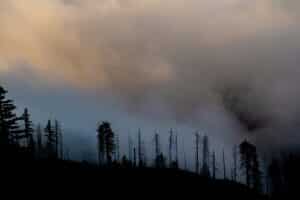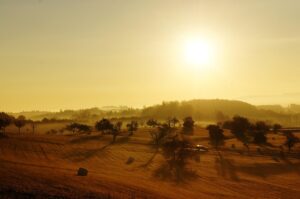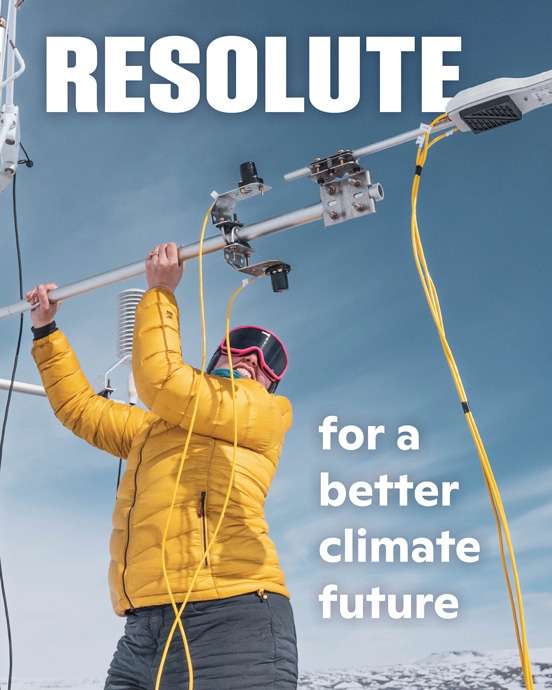Meeting the moment: Fund for Climate Solutions awards five new grants
From Mongolia to the Cerrado, FCS projects are tackling climate’s most pressing research questions
By Maggie Lin
The second round of 2025 Fund for Climate Solutions (FCS) awardees has been announced. The FCS advances innovative, solutions-oriented climate science through a competitive, internal, and cross-disciplinary funding process. Generous donor support has enabled us to raise more than $10 million towards the FCS, funding 79 research grants since 2018. In a volatile environment for climate research and policy, this summer’s five collaborative project teams are bringing their ambition and creativity to solutions that meet time-sensitive needs.
Additional funding will help to expand the Fund for Climate Solutions. If you are interested in learning more, contact Leslie Kolterman at lkolterman@woodwellclimate.org or (508) 444-1584.
Tracking forest structure and emissions from logging mature and old-growth forests on federal lands
Leads: Dr. Richard Birdsey, Dr. Wayne Walker, Seth Gorelik
The federal administration has ordered the Forest Service and Bureau of Land Management to increase logging of federal forests by 25% over the next few years, with detailed project-level planning expected before the end of 2025. There are few, if any, guardrails that protect the most valuable young, mature, and old-growth forests. With collaborators from Conservation Biology Institute, World Resources Institute, and Natural Resources Defense Council, this project will track carbon stock reductions from greatly scaled up logging, especially where it targets older forests. The team will also model the impacts of a 25% increase in logging across all federal lands. Their methods build upon extensive prior research, and will integrate data from satellite observations, forest inventories, and published activity reports to provide analysis that can support public engagement and policy analysis.
Mongolia grazing lands initiative: Knowledge co-production and mapping with Dukha reindeer herders in Mongolia
Leads: Greg Fiske, Christina Shintani, Jackie Dean
The Dukha people of Mongolia, like other Indigenous peoples, have lived respectfully and in harmony with the land since time immemorial. Now, their lifeways are being challenged by climate change and land use decisions made without proper consultation and consent. On the Mongolian Plateau, the rate of summertime warming is three times faster than the average for Northern Hemisphere lands, causing permafrost thaw and changes in vegetation. The project team will map land use changes impacting Indigenous grazing lands in Mongolia and train Indigenous reindeer herders in GIS map storytelling tools. Grounded in co-production of knowledge, this work will build on past successes working with Sámi reindeer herders in Norway and Indigenous communities in Alaska. It will also expand Woodwell’s rangeland work into East Asia, leveraging existing partnerships with Esri and the International Centre for Reindeer Husbandry.
A novel framework for defining and quantifying degradation in fire-prone tropical forests
Lead: Dr. Manoela Machado
Collaborators: Dr. Andréa Castanho, Dr. Marcia Macedo, Dr. Wayne Walker
Brazil’s vast tropical savanna, the Cerrado, is both a global biodiversity hotspot and a provider of vital ecosystem services. It is experiencing the highest deforestation rates among Brazilian biomes, driven primarily by the expansion of mechanized agriculture—nearly half of the Cerrado’s original vegetation is already lost. The region has weaker legal protections than the Amazon, resulting in land conversion being displaced into the Cerrado. Part of the challenge is that defining and measuring degradation in the Cerrado can’t be reduced to the loss of biomass alone: the biome is dependent on disturbances like fire that temporarily reduce biomass, but are also essential for sustaining ecological integrity. This project responds to increasingly urgent calls from government agencies, environmental nonprofits, and carbon market participants to develop an operational framework of Cerrado degradation that accounts for the ecosystem’s natural variability. This project will build Cerrado-specific definitions of degradation and deliver both a monitoring framework and a map assessing 2024 degradation. The team, including collaborators from IPAM and the University of Oxford, plans to build on these outcomes to seek funding for expanding this framework to other disturbance-dependent ecosystems, including savannas around the world.
Responsible solar geoengineering research and governance: Scoping a role for the Woodwell Climate Research Center
Lead: Dr. Peter Frumhoff
Collaborators: Dr. Jennifer Watts, Jamie Cummings, Dr. Brendan Rogers, Dr. Christopher Schwalm, David McGlinchey
Researchers and policymakers are increasingly assessing the effectiveness and risks of solar geoengineering—interventions intended to rapidly cool the Earth by reflecting a portion of incoming sunlight back into space. Woodwell Climate previously established an organizational position that “responsible research is needed to inform decision-making regarding whether and how solar geoengineering should ever be considered for deployment.” This project will investigate whether Woodwell should further responsibly-goverened solar geoengineering research, building on our strong position statement, our distinctive expertise in Arctic warming and federal policy engagement, and our relationships with Arctic Indigenous communities. The team will invite expert speakers for presentations to Woodwell staff; hold a series of scoping interviews with leading researchers, NGOs, Arctic community thought-leaders, and philanthropists; and co-convene an international workshop with the Harvard Kennedy School’s Arctic Initiative.
Understanding how wildfire impacts permafrost thaw depths
Leads: Dr. Anna Talucci, Dr. Brendan Rogers
Collaborators: Dr. Elchin Jafarov, Dr. Kayla Mathes, Dr. Christina Schädel
When high-latitude northern landscapes experience wildfire, plants and organic matter in the soil are burned away, leading to increased soil temperatures and permafrost thaw. Dr. Anna Talucci previously led a publication that synthesized existing research to drastically increase the amount of data that is available to modelers on the depth of actively thawing and re-freezing ground in burned and unburned research sites across the northern tundra and boreal regions. This project will build on that data to investigate what drives active layer recovery and fill key gaps to support permafrost modeling by Woodwell researchers. The team aims to publish their findings in a scientific journal and submit an abstract to present to colleagues at the next American Geophysical Union annual meeting. They will also develop a funding proposal to seek support in investigating the questions their research reveals about more complex permafrost-wildfire interactions.
Trees play a crucial role in mitigating the effects of climate change by absorbing climate-warming carbon dioxide from the atmosphere. As temperatures climb and human activities release more and more carbon, managing and protecting trees has become essential to curbing global warming.
In 2021, partners at Woodwell Climate Research Center, Local Governments for Sustainability (ICLEI), and the World Resources Institute (WRI) launched a tool providing communities with fine-scale information about their trees to better manage and protect them.
The Land Emissions and Removals Navigator (LEARN) tool is an interactive map and data analysis system that contains remote sensing and forest inventory data on tree cover, land use change, disturbances, and carbon stocks. Users – mostly county and municipal planners – can generate a custom estimate of carbon emissions and removals from trees for any area in the contiguous United States.
“That’s the idea with the LEARN tool – it makes these complicated datasets readily accessible,” Dr. Rich Birdsey, Senior Scientist at Woodwell Climate and collaborator on LEARN, says.
Easily accessible tree cover data gives community members the opportunity to take action at the local level. For example, a city planner might use LEARN to see if trees are gaining or losing cover in their city. If trees are losing cover, they can work with their municipal departments to increase the urban canopy.
In the last year, scientists added the ability to identify mature and old-growth (MOG) forests to the tool. MOG forests are the later stages of forest development, where trees are larger and store more carbon than younger forests. They are also more resilient and adaptive in the face of disturbances and play a role in maintaining biodiversity by providing habitat for wildlife. This makes them a high priority for protection.
In addition, users can now view the protection status of an area. Ranging from low to high, they describe what activities – like logging and mining – are allowed in the area. Users can draw connections between activities and carbon estimates, and hopefully, change local land management practices to better protect their trees.
LEARN’s protection statuses include:
- Low Protection: These areas lack full protection from land conversion, with some allowing extractive uses like logging or mining while protecting endangered species, and others having no mandates preventing habitat conversion, often involving private or developed lands.
- Medium Protection: This category includes USFS Inventoried Roadless Areas, which currently have protection from land conversion, but allow for moderate uses or management practices, not including commercial timber harvest, that may impact natural communities.
- High Protection: These areas have permanent protection from land conversion or active management, maintaining a natural state with only a few exceptions such as addressing safety concerns.
“The assessment is more relevant now because the Department of Agriculture has proposed a rule that would relax forest protections, particularly with respect to roadless areas,” Birdsey says.
In June, U.S. Secretary of Agriculture Brook Rollins announced that the U.S. Department of Agriculture is rescinding the 2001 Roadless Rule. The rule protected 58 million acres of roadless land within the National Forest System from construction and commercial logging. With no protections for roadless areas, logging and commercial uses of land will be allowed.
“Because of the large area currently designated as roadless, and the significant area of mature and old-growth forests within these areas, this is of great concern to the conservation community,” Birdsey says.
Birdsey hopes that the LEARN tool can mobilize community members and land managers to take action. Whether it be working with local governments to protect MOG forests or connecting neighboring counties to each other, communities can collaborate to tackle climate change on a local level.
“Since federal policies are opening up more public land to logging, it is becoming more important than ever for local communities to weigh in on forest management plans,”Birdsey says.
IPCC concludes selection of authors for its Seventh Assessment Report

The Intergovernmental Panel on Climate Change (IPCC) has appointed 664 experts from 111 countries to participate in the Seventh Assessment Report (AR7) as Coordinating Lead Authors, Lead Authors and Review Editors.
These experts were nominated by governments and IPCC observer organisations and selected by the IPCC Bureau from a global pool of 3,771 nominees.
Read more on the IPCC website.
The EPA’s 2009 Endangerment Finding has underpinned almost all U.S. efforts to reduce greenhouse gas emissions, making it a prime target for the Trump administration’s rollback of climate policies. A day-one executive order included a directive to review the “legality and continuing applicability” of the finding. On March 12, the EPA announced that it would potentially rescind the Finding, and the announcement was formalized with a proposed rule on July 29.
Repealing the Finding would undo more than a decade of work that has made American communities healthier, skies clearer of smog and other pollution, and contributed to the country’s decreasing carbon emissions.
What is the Endangerment Finding?
The Endangerment Finding is a pivotal determination by the EPA, issued in response to the 2007 U.S. Supreme Court Case Massachusetts vs. EPA. In that case, the court held that the EPA has the authority to regulate greenhouse gases under the Clean Air Act, and that after it has made a finding of endangerment, the agency cannot refuse to regulate these gases.
Additionally, the EPA found that greenhouse gases in the atmosphere are both a hazard to public health and that motor vehicle emissions contribute to this pollution. In the years since, the EPA has built on the original ruling and issued subsequent endangerment findings relating to aircraft and utility emissions under other provisions of the Clean Air Act .
Why is the Endangerment Finding important?
As a result, the Endangerment Finding has become the legal foundation for essentially all federal regulation of greenhouse gas emissions in the U.S. – including motor vehicle tailpipe emissions and power plant rules.
The EPA’s proposed rule would repeal all greenhouse gas emissions standards for light-duty, medium-duty, and heavy-duty vehicles and engines, and would preempt any state fuel efficiency or vehicle emissions laws or regulations. Furthermore, this repeal could be a foundation for undoing greenhouse gas emissions regulations on stationary sources like power plants or oil and gas facilities.
The Endangerment Finding is based on sound science
The attempt to repeal the Endangerment Finding is emblematic of the current administration’s disregard for scientific consensus around the causes and impacts of climate change.
The original finding draws from expertise at the U.S. Global Change Research Program, the Intergovernmental Panel on Climate Change (IPCC), and the National Academies of Sciences. It examined public health and public welfare in the U.S., with a focus on air quality, food production and agriculture, forestry, water resources, sea level rise and coastal areas, energy, infrastructure, and settlements, and ecosystems and wildlife. The EPA received over 380,000 public comments, the majority of which provided support for the Finding.
In 2018, Dr. Philip Duffy, then-president of Woodwell Climate Research Center, led a review of the scientific foundation of the Endangerment Finding. That work, published in the journal Science, found that “for each of the areas addressed in the EF, the amount, diversity, and sophistication of the evidence has increased markedly, clearly strengthening the case for endangerment. New evidence about the extent, severity, and interconnectedness of impacts detected to date and projected for the future reinforces the case that climate change endangers the health and welfare of current and future generations.”
What’s next for climate policy?
The legal validity of the administration’s proposed rule was contested almost immediately and challenges will likely continue to roll in even if the rule is made official.
The EPA has extended a public comment period on this topic through September 22, 2025. The recently released Department of Energy (DOE) report, A Critical Review of Impacts of Greenhouse Gas Emissions on the U.S. Climate, which challenges scientific consensus by claiming that carbon dioxide-induced warming appears to be less damaging economically than commonly believed, serves as a foundation for the EPA’s proposed rule. That report is also open for public comment through September 2, 2025.
The National Academy of Sciences has fast-tracked its scientific review of the impacts of greenhouse gases on human health in order to inform the decision within the comment period, and has requested contributions from scientists and experts in the fields of public health, extreme weather, climate modeling, agriculture, and infrastructure. Woodwell Climate is contributing to the opportunities for public comment and scientific engagement to aid future consideration of this, and similar, proposals in courts and encourages members of the public to do the same.
As Canada wildfires choke US with smoke, Republicans demand action. But not on climate change

The sternly worded statements and letters are filled with indignation and outrage: Republican U.S. lawmakers say Canada has done too little to contain wildfires and smoke that have fouled the air in several states this summer.
“Instead of enjoying family vacations at Michigan’s beautiful lakes and campgrounds, for the third summer in a row, Michiganders are forced to breathe hazardous air as a result of Canada’s failure to prevent and control wildfires,” read a statement last week from the state’s GOP congressional delegation, echoing similar missives from Republicans in Iowa, New York, North Dakota, Minnesota and Wisconsin.
They’ve demanded more forest thinning, prescribed burns and other measures to prevent fires from starting. They’ve warned the smoke is hurting relations between the countries and suggested the U.S. could make it an issue in tariff talks.
Experts emphasize need for Interior Alaska wildfire mitigation

Earlier this summer, Interior Alaska wildfires were so widespread, Fairbanks resident Nettie La Belle-Hamer had to prepare a go-box in case the flames encroached too closely on her home.
La Belle-Hamer, deputy director of the University of Alaska Fairbanks Geophysical Institute, brought that firsthand experience along with plenty of scientific knowledge to this year’s Arctic Encounter Symposium, an annual conference focused on the region.
La Belle-Hamer was joined by four other panelists — three of whom live in the Interior — to discuss methods to address wildfires in the Arctic, as well as strategies to implement fire mitigation in the Arctic to protect permafrost melt.
Continue reading on Anchorage Daily News.
In the northern ecosystems of the Alaskan boreal forest and tundra, wildfire is a natural – and even necessary – process. But as temperatures rapidly warm, wildfire frequency and severity in the state are breaking historical records.
Scientists at Woodwell Climate Research Center are studying the effects of these increased fires on the ecosystem. In a study published earlier this year, a research team led by Research Scientist Dr. Scott Zolkos examined the relationship between northern wildfires and one concerning byproduct of them: mercury pollution.
Higher temperatures, more wildfires, more pollution
In the last 25 years, Alaska has experienced some of the worst fire seasons on record. One of the reasons behind this is that climate change is hitting the north harder than other regions.
Northern latitudes, including the Arctic and boreal regions, are warming three to four times faster than the rest of the planet. As warmer temperatures melt snow earlier in the year and dry out soil and vegetation, the fire season lengthens and intensifies. According to Woodwell scientists, 2024 was the second-highest year for wildfire emissions north of the Arctic Circle.
“It’s really sort of a new phenomenon, the level of burning we’re seeing in the tundra,” Dr. Brendan Rogers, Senior Scientist, says.
Increasing fires means increasing air, water, and ecosystem pollution from the byproducts of burning vegetation and soils. Mercury is a toxic pollutant in wildfire smoke, but there is sparse research on mercury release from northern peatland wildfires which means scientists don’t yet have a great understanding of how increasing northern wildfire activity could counteract efforts to curtail human-caused mercury release. To understand these impacts, Zolkos and collaborators studied areas of the Yukon-Kuskokwim (YK) Delta in southwestern Alaska— a peatland environment that burned in 2015. The summer of 2015 made history as one of Alaska’s worst fire seasons, with over 5 million acres of land burned.
The research team used peatland soil samples that were collected between 2016 and 2018 by undergraduate participants of The Polaris Project to measure mercury. They then used the new mercury data together with organic carbon and burn depth measurements from another recent study to develop models that predicted mercury emissions from the 2015 wildfires.
Measuring mercury release
Mercury continuously cycles through the environment in air, water and soil, often changing between liquid and gaseous forms. It enters the atmosphere as emissions from human activities like the burning of fossil fuels and natural processes like wildfires and volcanoes. High levels of mercury can accumulate in the ground when vegetation takes up mercury from the atmosphere, then decomposes and deposits it into the soil. In northern peatlands, mercury has been accumulating with organic matter for thousands of years.
Mercury emissions occur when wildfire burns organic matter in soil and releases mercury that is bound to it back into the atmosphere. With increased temperatures and wildfire activity, the stabilization accumulation of mercury in the soil is threatened – and so is air quality.
“There are huge mercury stores in northern peatlands,” Zolkos says. “If peatlands burn more, it could potentially offset global efforts to reduce human mercury release into the environment.”
Zolkos and collaborators found that levels of mercury in peat in the YK Delta were similar to those in peatlands elsewhere in the north. Using an atmospheric chemical transport model developed by collaborators, the researchers also found that mercury deposition within 10 kilometers of wildfire sites was two times higher than normal, even though the majority of emissions from the fire traveled beyond Alaska.
With this information, Zolkos believes that increasing fire activity has the potential to unlock large amounts of soil-bound mercury in the North. The challenge now is figuring out exactly how much mercury is being released and where it ends up.
As a step to understanding this, Zolkos is leading a pilot project to develop an atmospheric mercury monitoring network across wildfire-susceptible peatlands in Alaska and Canada. Twenty-six air samplers, which collect mercury molecules in the air, were deployed at seven sites in Arctic-boreal peatlands across Alaska and Canada during the summers of 2024 and 2025. After the 2025 summer season is complete, the samplers will be sent to a lab at Harvard University, where Zolkos will measure their mercury content.
“Our goal is to work with collaborators to deploy these simple and cost-effective samplers that capture mercury in the atmosphere,” Zolkos says. “And from that, we can back-calculate the concentration of mercury in the air to understand wildfire impacts.”
By studying trends, Zolkos can compare levels of mercury in the air in areas affected and not affected by wildfire. And with added contextual data, scientists can model how much mercury might have been released from the soil and vegetation by wildfire.
Understanding wildfire impacts on air quality
In addition to containing mercury, wildfire smoke also emits particulate matter (PM2.5). PM2.5 refers to particles that are smaller than 2.5 micrometers in diameter – thirty times smaller than the average human hair. When breathed in, they can affect the heart and lungs and cause a variety of health problems, including aggravated asthma, decreased lung function, and increased respiratory symptoms.
Together with collaborators from the Permafrost Pathways project, Zolkos is also collaborating with Alaska Native communities to install PurpleAir sensors, a system of particulate matter monitors, to support tribally-led wildfire air pollution monitoring. This project helps to address monitoring needs in Alaska, where nearly 90% of rural communities reached or exceeded unhealthy levels of PM2.5 at least once due to wildfire in the last two decades.
“It’s a really great opportunity to work together with Alaskan Native communities and also to share knowledge, learn from them, and try and help them with any needs that they have for environmental monitoring,” Zolkos says.
So far, particulate matter sensors have been deployed in Pond Inlet in Nunavut, Canada, Churchill in Manitoba, Canada, and Akiachak, Alaska.
“The complex impacts of wildfire on Arctic and global communities is not something that can be solved by taking a measurement and seeing a number alone. These climate health impacts require a more holistic way of thinking and doing research” Dr. Sue Natali, Senior Scientist and lead of the Permafrost Pathways project, says. “What gives me hope is that the Western scientific community is now listening and hearing more from Indigenous partners to co-produce research to support climate resilient communities,”
Late July’s oppressive heat forecast isn’t normal
A punishing heat wave will bring hot temperatures to eastern US and linger for several days, underscoring how climate change heats things up.

As the clock ticks down the final days of July, thermometers will climb across much of the eastern half of the United States, creating a dangerous and long-lasting heat wave that will put millions at risk of heat stroke and other illnesses.
Those in the path of the heat wave should plan to take extra measures to stay cool through at least July 30. Keep things chill by staying in air-conditioned spaces, visit friends with pools, pile up the popsicles and lemonade and pull out the recipe for your favorite cold summer salad.




